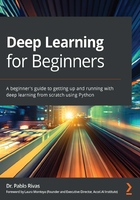
Summary
In this chapter, we discussed many data manipulation techniques that we will come back to use all the time. It is good for you to spend time doing this now rather than later. It will make our modeling of deep learning architectures easier.
After reading this chapter, you are now able to manipulate and produce binary data for classification or for feature representation. You also know how to deal with categorical data and labels and prepare it for classification or regression. When you have real-valued data, you now know how to identify statistical properties and how to normalize such data. If you ever have the problem of data that has non-normal or non-uniform distributions, now you know how to fix that. And if you ever encounter problems of not having enough data, you learned a few data augmentation techniques. Toward the end of this chapter, you learned some of the most popular dimensionality reduction techniques. You will learn more of these along the road, for example, when we talk about autoencoders, which can be used for dimensionality reduction as well. But sit tight, we will get there in due time.
For now, we will continue our journey toward the next introductory topic about basic machine learning. Chapter 4, Learning from Data, introduces the most elementary concepts around the theory of deep learning, including measuring performance on regression and classification, as well as the identification of overfitting. However, before we go there, please try to quiz yourself with the following questions.